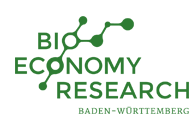Development of cell disruption and extraction processes for the cascade utilization of microalgae biomass
Microalgae contain a broad range of ingredients that could potentially be used in the food and feed sector. Depending on the specific strain and the cultivation conditions (e.g. nutrient supply, light intensity, pH-value and temperature) they produce high amounts of storage lipids in the form of triacylglycerides (up to 70% of dry weight), proteins (up to 50% of dry weight), polyunsaturated omega-3 fatty acids like eicosapentaenoic acid (up to 7% of dry weight) and different micronutrients like phytosterols and carotenoids.
Due to the broad range of valuable products and specific cell wall properties of different microalgae species, elaborate down-stream processing is necessary to extract and fractionate high quality nutrients. So far available down-streaming processes for the utilization of microalgae biomass were designed to yield low-prized products for energy production such as fatty acids for biodiesel. As a result, these methods do not meet requirements and regulations of the food and feed sector. Furthermore, they were focused on the production of one specific product, whereas the sustainable use of microalgae biomass in the bioeconomy calls for a holistic utilization of the biomass in cascade uses.
Within the frame of this project, different cell disruption and nutrient extraction methods were examined using three microalgae species varying in cell size, cell wall properties and ingredients. While Phaeodactylum tricornutum contains high amounts of protein and polyunsaturated membrane-bound lipids, Chlorella vulgaris is rich in storage lipids (triacylglycerides). Nannochloropsis sp. contains proteins and triacylglycerides as well as polyunsaturated membrane lipids. Suitable cell disruption techniques (e.g. stirred ball mill and extraction techniques (e.g. supercritical CO2 extraction with co-solvents and accelerated solvent extraction), that are applicable within the food sector, were successfully applied to fractionate different microalgae biomasses as gently and selectively as possible. Subsequently, the nutritional quality and techno-functional properties of each fraction were analyzed in partner projects.
As a result of this project, suitable processes were established that can be transferred to other microalgae species with different ingredient composition or cell wall properties and on various application goals. The results show that especially the lipophilic fractions derived from the microalgae biomass provide a high potential for future food applications.
| Project title | Development of cell disruption and extraction processes for the cascade utilzation of microalgae biomass |
| Institution | University of Stuttgart, Institute of Interfacial Process Engineering and Plasma Technology |
| Research group | Dr. Ursula Schließmann, Felix Derwenskus (Universität Stuttgart) Dr. Ulrike Schmid-Staiger (Fraunhofer IGB) |
| Project status | completed |

